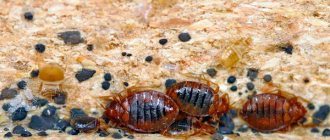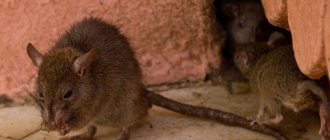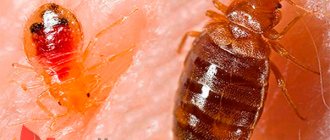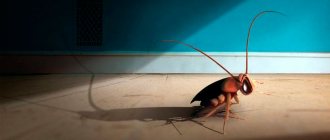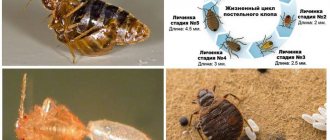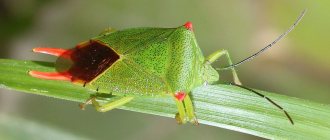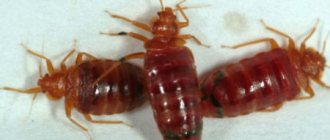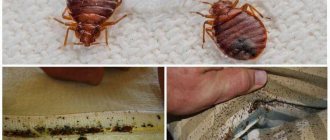Normally, after good quality treatment, bedbugs die within an hour or two, and in another 1-2 days those insects that were not directly affected by the insecticide during treatment are poisoned.
Bed bugs collected immediately after treatment
According to SanMariDez statistics, after 67% of our treatments not a single living bug is found within 2-3 hours after disinfestation, in 14% of treatments the bedbugs live for another 1-2 days, after which they disappear, in 3% of treatments they die on the third or fourth day, and in other cases they either do not die completely, or appear again during the first week and need to be poisoned again.
For the most part, after baiting, bedbugs die when they try to get out of their shelters at night and find a sleeping person, and in their movements crawl through a layer of dried insecticide. Since conscientious disinfectors always use preparations with a long residual effect to bait bedbugs, it is not particularly important how long it takes for these unsprayed bedbugs to get out of their nests - they cannot do this less than once every 4-5 days, since exactly once every 4-5 days they feed, and high-quality insecticides continue to act for 2-3 weeks after application to the surface and drying.
But this is normal. According to our statistics, approximately 22-23% of situations go beyond the limits of this norm, and in these cases, in apartments, houses or work premises, bedbugs either die after treatment a little longer, or some of them live a long time and in order to exterminate them it is necessary to carry out repeated disinfestation .
We deal with all these situations very carefully, since it is extremely important for us to maximize the number of treatments, after which the bedbugs die quickly and do not appear again. To do this, we take into account not only our experience, but also the experience of our clients who poisoned bedbugs themselves before contacting us, or ordered treatments from other specialists (or not quite specialists).
Thanks to this, we know almost all the reasons why these parasites can survive in premises after disinfestation, and we take them into account when our specialists go out for disinfection. And by looking at how long bedbugs live in an apartment after treatment, you can understand why they actually live and do not disappear immediately. Here's how we define it:
Situation 1. Bedbugs die immediately and do not appear again after treatment
This is exactly how events should develop after disinfestation. Normally, before treatment, the disinfectant opens all the hiding places of bedbugs, and then, when spraying the room with cold fog in all these places, the insecticide hits the bedbugs and kills them in a matter of minutes.
Bedbug nest under sofa upholstery
The drug may not penetrate into individual nests immediately, but within half an hour to an hour, while it is in the form of fog in the air and, with its current, is drawn into various cracks, cavities and holes.
In the same situation, a very small part of the bedbugs in the apartment (a few, or a few dozen) can survive in the most inaccessible shelters where the insecticide has not penetrated. But these same individuals will die from the action of the dried drug on surfaces at the very first attempts to get out of their shelters and find a person to drink blood. As a result, people will not see them and, in general, the apartment will look as if the bedbugs died out immediately during disinfestation.
In our practice, such cases account for approximately 67% of all bedbug treatments. As a rule, this is how the situation develops in apartments with normal renovation, a standard number of beds and low and moderate infestation.
If there is no re-infestation, then after such disinsection, bedbugs will no longer appear in the apartment. Sometimes when cleaning, homeowners may find the remains of dead bedbugs, but there are no living insects left here.
Methods of destruction
To treat habitats, you can use sprays from specialized stores, but keep in mind that these products will only help with direct contact with parasites.
The most effective chemicals are:
- Delta Zone is a microcapsule composition from Korea that provides protection for up to 4 months and is odorless.
- Get is a suspension with microcapsules that creates a barrier for six months,
- Xulat Micro is a Spanish composition with three active ingredients, odorless,
- Cucaracha is a budget composition to completely destroy bedbugs, but it has an odor and may require re-treatment,
- Tsifoks is a concentrate for self-treatment of an apartment; it has a slight smell of kerosene.
Situation 2. Bedbugs appear in the first 2-3 days after baiting, and then disappear
This usually happens for two reasons:
- There were a lot of bedbugs in the room before treatment, and a significant number of them survived the disinfestation. These individuals are poisoned with dry insecticide in the first days after baiting and die. They are no longer noticed in the apartment.
- The processing was not high-quality and thorough enough, but the product itself is very powerful. It was not possible to get all the bugs directly with the drug; some of them survived, but then within a few days they were poisoned with the dried product and died.
We encounter the first reason very often: we are regularly called to heavily infested apartments, where there are many hundreds of bedbugs, they literally swarm in sofas and under mattresses, accumulate behind baseboards and scatter in many other hiding places, where it can be difficult not only to poison them, but also easy to find. Even in such cases, they can be poisoned by cold and hot fogs so that they die immediately. But usually, the worse the condition of the apartment, the more cash-strapped the customer (usually pensioners, disabled people and seasonal workers) who cannot afford hot fog treatment and imported products. And in such conditions, only the cold fog of domestic preparations turns out to be weak, and some of the bedbugs last for several more days. Fortunately, we spare no expense and there is so much of it left on surfaces that bedbugs cannot survive in such a room.
If the surface on which the bugs are now located was treated with an insecticide with a residual effect, then this couple is already a suicide bomber Photo © AlexWild
The second reason rarely arises: if a person shells out for an expensive, powerful product, then he usually takes a responsible approach to its use. But it happens that a person buys a product, but cannot use it correctly. As a result, he sprays the top of the sofa, bed, or chair, floors and bottom of the walls, and calms down. All bedbugs do not die during this spraying, but on subsequent nights they begin to crawl out of their hiding places and try to bite sleeping people. But at the same time, they land on treated surfaces, collect insecticide on their paws, get poisoned and die.
We do not have such cases, since our disinfectors work ultra-thoroughly. But our clients told us about similar situations, who either poisoned bedbugs themselves in this way, or had the premises treated by other contractors who were equipped with good products, but did not know how to use these products.
Be that as it may, in such situations, bedbugs live in an apartment for 2-3 days, no more.
Situation 3. Bedbugs disappear after treatment, and then after a week or two they begin to bite again
This situation is already ambiguous and can be caused by two reasons:
- People begin to be bitten by larvae that hatch from eggs laid by females even before treatment. Insecticides have little effect on these eggs, but the larvae must be poisoned with a dry preparation. If the drug itself is weak, or there are a lot of larvae, some of them may survive and begin to bite.
- Bedbugs entered the apartment again from neighbors' premises.
Diagnosing the cause in such a situation is relatively easy: if very small bugs bite, but adults cannot be found, then these are precisely the larvae that hatched indoors. If adult bedbugs bite after a significant break (more than a week), then they most likely climbed into the room again. Small larvae do not make long migrations from apartment to apartment, and therefore such re-infestation can be carried out by adults.
Nymph of the last instar and a brood of the smallest nymphs
Very rarely these reasons appear simultaneously. In this case, you can understand that the bedbugs were poisoned during treatment and appeared again, and did not just start biting, by the interval of 5-10 days, during which there were no bites: if the bedbugs had not been poisoned during treatment, they would They bit almost non-stop.
This situation in both cases requires repeated disinfestation. If the larvae bite, they can be relatively easily destroyed with the same preparation that was previously used to kill the bugs during the first treatment. If adult bedbugs bite, then re-treatment should be carried out with a product based on an active substance, not the same as that used in the previous baiting .
On a note
It is extremely important to poison newly hatched larvae within 10-15 days after the first disinfestation. During this period, a new generation will hatch from all the eggs, but not a single larva will have time to develop into an adult and lay its own eggs. The goal here is to treat the room when there are no insecticide-resistant eggs in it. If this is done, then all the larvae will die and there will be no more bedbugs or their eggs left in the apartment.
Situation 4. Bedbugs disappear for a long time (more than a month), but then appear again
Here we are almost certainly talking about re-infestation of the premises: bedbugs are either brought by people in their belongings or with furniture, or they themselves crawl into the apartment from neighboring premises. For more than a month, live bedbugs will not sit in a room where people constantly spend the night without biting their victims, and if there was such a long period of no bites, it means that there were no bedbugs in the apartment at that time.
In this situation, repeated disinfestation is required immediately after identifying bedbugs that have again entered the apartment.
Heavy artillery
When pests get indoors, homeowners are often tempted to try to solve the problem themselves. However, the truth is that most pests—from bedbugs and termites to wasps and other biting insects—are best left to exterminators. Professionals have the knowledge and tools to safely and correctly eliminate pest infestations.
If you are concerned about an infestation on your property, it is best to hire licensed local pest control professionals to assist in properly identifying and treating your home bed bug problem.
Situation 5: Bedbugs live in an apartment and continue to bite without interruption after treatment
This happens when ineffective drugs are used against bedbugs, or even when effective drugs are used incorrectly. Some of them may die during etching, but a significant number survive and continue to bite as if nothing had happened.
Bugs on the fold of soft parts of the sofa
In such a situation, repeated treatment is required 10-12 days after the first. Such a repetition must necessarily be carried out with a means different from that used before, and based on a different active substance.
If this situation is repeated many times, it means that the problem is not in the means, but in the quality of processing. We encounter similar cases regularly when we see people trying to poison bedbugs themselves. They seem to be using good means, but they are doing it completely wrong. Because of this, bedbugs survive safely and survive many treatments in a row.
According to our statistics, more than 90% of independent treatments for bedbugs do not produce results, regardless of the quality of the product. At the same time, people often do not understand the differences between the groups of products and, for example, first poison the bedbugs with Karbofos, and then try to change the drug, and buy Fufanon for repeated baiting. People don’t know that these products are analogues of each other and work identically.
What’s worse is that, according to surveys of our clients, 65% of treatments from private SES do not produce results in the same way - from such companies, completely unprepared people often come to calls, who just yesterday decided to start poisoning bedbugs, having not found another job, and do not know about this activity nothing at all. Accordingly, the result of their work turns out to be the same as the result of the apartment owners’ independent fight against bedbugs. This is bad not only because people spend significant time and money on such pseudo-specialists, but also because such under-processing greatly reduces trust in pest control services in general. We then have to restore this trust for a long time, both through high-quality pest control and persuasion.
Feeding features of bedbugs
The blood of warm-blooded creatures is the only suitable food for parasites. These insects most often attack people. This is due to the fact that it is difficult for pests to penetrate the hard outer shell of animals and birds with their mouthparts. Human skin is softer and blood vessels are often located closer to the surface, making it even easier for pests to find food.
Domestic parasites of this species attack humans during sleep. They mostly do this at night, but bedbugs often bite a person while sleeping during the day, under special conditions, for example, when the victim is outside the house for a long time. The best time to eat is between 2 and 5 am. A person does not awaken from the weak activity of parasites, because sleep at this stage is the deepest.
Before eating, the insect injects saliva under the skin, which contains substances that anesthetic the bite. As a result, the person does not feel anything, and in the morning he discovers red spots.
The larvae do not yet have this ability, so their bites are painful.
